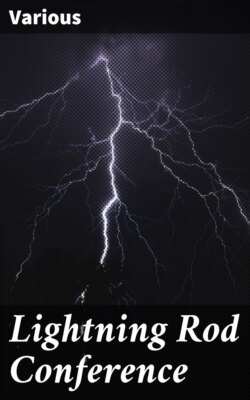Читать книгу Lightning Rod Conference - Various - Страница 27
На сайте Литреса книга снята с продажи.
APPENDIX D.
REPORT OF THE REPRESENTATIVES
OF THE
ROYAL INSTITUTE OF BRITISH ARCHITECTS
TO THE
LIGHTNING ROD CONFERENCE.
ОглавлениеTable of Contents
The Council of the Royal Institute of British Architects sent out upwards of 600 circulars (a copy of which follows this Report) to their Architectural Members requesting information as to injury by lightning to any buildings known to them.
The Council also requested the same information from their Honorary Associates (upwards of 100 in number), who are chiefly men eminent in the Scientific, Literary, and Artistic world.
The Council have received up to this date only 35 answers from Architects, and 1 from the Honorary Associates.
Of these answers many are to the effect that no case of injury has arisen to works under their direction. The remainder give 33 instances of damage, and enter, in many cases, very fully into the details of them.
The instances given may be roughly classified thus:—
There are 26 of buildings injured where there were no conductors.
In 9 of these the lightning did some injury to the chimneys and other exposed parts, and was then conducted safely to the ground through the metal gutters and rain water pipes.
In three other instances the lightning appears, from the statement of persons in the building struck, to have dispersed and passed out by open doors, &c.
We give no opinion as to this, but the facts are distinctly stated. In several other cases the lightning passed off in several distinct directions and currents.
There are 6 cases of buildings being injured although protected by lightning conductors. In one of them (No. 14) the failure is clearly explained by the fact that the lower part of the conductor had been stolen, leaving only two or three feet of it in the ground. The lightning in this case broke through a wall 4 feet 6 inches thick, at a height of 6 feet from the floor to a gas pipe.
In another case (No. 3) a gable was struck, although close to a spire and turret which had a lightning conductor.
In another (No. 7) the part struck (a chimney) was 64 feet away from a tower, in the same building having a lightning conductor.
In No. 24 the conductor was sufficient protection until it passed at a sharp bend round some mouldings; these it injured, but did no further damage.
In two cases (Nos. 21 and 23) the discharge injured some gas tubing near it, and set fire to the gas, and by its means to the building.
We beg finally to call attention to the drawings attached to No. 7 (Mr. Colson, of Winchester), showing the injury to trees 130 feet away in a direct line from a spire which was destroyed, it having no conductor.
T. HAYTER LEWIS, V.P.
JOHN WHICHCORD, V.P.
